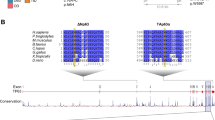Abstract
Polycystic ovary syndrome (PCOS) is a complex and heterogeneous disorder presenting a challenge for clinical investigators. To investigate the association of a mitochondrial genetic basis with PCOS, we screened mutations of the whole mitochondrial genome in 57 women patients with PCOS and 38 healthy control individuals. Two-step PCR reactions were adopted to amplify and sequence the whole mitochondrial genome. A 9-bp deletion variant appeared in homoplasmy between PCOS patients and control individuals. In the 62 individuals with complete sequences, eight of 34 (23.5%) patients showed the 9-bp deletion, compared with only two of 28 (7.1%) in healthy controls. The 9-bp deletion variant in region V of mitochondrial DNA may be associated with the heterogeneous disorder PCOS.

Similar content being viewed by others
References
Anderson S, Bankier AT, Barrell BG, de Bruijn MH, Coulson AR, Drouin J, Eperon IC, Nierlich DP, Roe BA, Sanger F, Schreier PH, Smith AJ, Staden R, Young IG (1981) Sequence and organization of the human mitochondrial genome. Nature 290:457–465
Diamanti-Kandarakis E, Piperi C (2005) Genetics of polycystic ovary syndrome: searching for the way out of the labyrinth. Hum Reprod Update 11:631–643
Diamanti-Kandarakis E, Kouli CR, Bergiele AT, Filandra FA, Tsianateli TC, Spina GG, Zapanti ED, Bartzis MI (1999) A survey of the polycystic ovary syndrome in the Greek island of Lesbos: hormonal and metabolic profile. J Clin Endocrinol Metab 84:4006–4011
Ewing B, Green P (1998) Base-calling of automated sequencer traces using phred. II. Error probabilities. Genome Res 8:186–194
Ewing B, Hillier L, Wendl MC, Green P (1998) Base-calling of automated sequencer traces using phred. I. Accuracy assessment. Genome Res 8:175–185
Franks S, Gharani N, Waterworth D, Batty S, White D, Williamson R, McCarthy M (1997) The genetic basis of polycystic ovary syndrome. Hum Reprod 12:2641–2648
Franks S, Gharani N, McCarthy M (2001) Candidate genes in polycystic ovary syndrome. Hum Reprod Update 7:405–410
Gordon D, Abajian C, Green P (1998) Consed: a graphical tool for sequence finishing. Genome Res 8:195–202
Naviaux RK (2000) Mitochondrial DNA disorders. Eur J Pediatr 159(Suppl 3):S219–S226
Rotterdam ESHRE/ASRM-Sponsored PCOS Consensus Workshop Group (2004) Revised 2003 consensus on diagnostic criteria and long-term health risks related to polycystic ovary syndrome. Fertil Steril 81:19–25
Schlotterer C, Tautz D (1992) Slippage synthesis of simple sequence DNA. Nucleic Acids Res 20:211–215
Schon EA, Rizzuto R, Moraes CT, Nakase H, Zeviani M, DiMauro S (1989) A direct repeat is a hotspot for large-scale deletion of human mitochondrial DNA. Science 244:346–349
Schon EA, Bonilla E, DiMauro S (1997) Mitochondrial DNA mutations and pathogenesis. J Bioenerg Biomembr 29:131–149
Skov V, Glintborg D, Knudsen S, Jensen T, Kruse TA, Tan Q, Brusgaard K, Beck-Nielsen H, Hojlund K (2007) Reduced expression of nuclear-encoded genes involved in mitochondrial oxidative metabolism in skeletal muscle of insulin-resistant women with polycystic ovary syndrome. Diabetes 56:2349–2355
Taylor RW, Taylor GA, Durham SE, Turnbull DM (2001) The determination of complete human mitochondrial DNA sequences in single cells: implications for the study of somatic mitochondrial DNA point mutations. Nucleic Acids Res 29:E74-4
Urbanek M, Legro RS, Driscoll DA, Azziz R, Ehrmann DA, Norman RJ, Strauss JF 3rd, Spielman RS, Dunaif A (1999) Thirty-seven candidate genes for polycystic ovary syndrome: strongest evidence for linkage is with follistatin. Proc Natl Acad Sci USA 96:8573–8578
Urbanek M, Du Y, Silander K, Collins FS, Steppan CM, Strauss JF 3rd, Dunaif A, Spielman RS, Legro RS (2003) Variation in resistin gene promoter not associated with polycystic ovary syndrome. Diabetes 52:214–217
Wickenheisser JK, Quinn PG, Nelson VL, Legro RS, Strauss JF 3rd, McAllister JM (2000) Differential activity of the cytochrome P450 17alpha-hydroxylase and steroidogenic acute regulatory protein gene promoters in normal and polycystic ovary syndrome theca cells. J Clin Endocrinol Metab 85:2304–2311
Acknowledgments
This study was supported by grants from the Science and Technology Foundation of Zhejiang Province (No. Y204327).
Author information
Authors and Affiliations
Corresponding author
Rights and permissions
About this article
Cite this article
Zhuo, G., Feng, G., Leng, J. et al. A 9-bp Deletion Homoplasmy in Women with Polycystic Ovary Syndrome Revealed by Mitochondrial Genome-Mutation Screen. Biochem Genet 48, 157–163 (2010). https://doi.org/10.1007/s10528-009-9308-5
Received:
Accepted:
Published:
Issue Date:
DOI: https://doi.org/10.1007/s10528-009-9308-5




